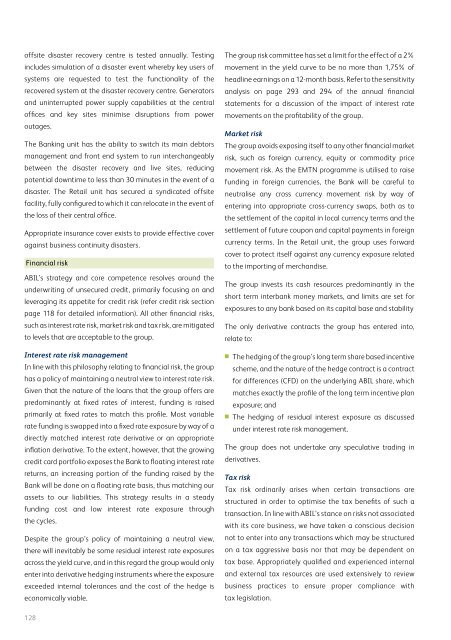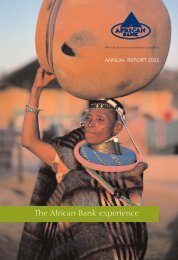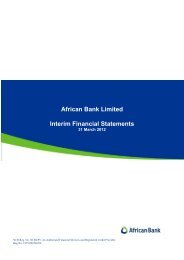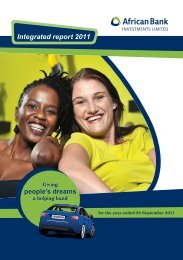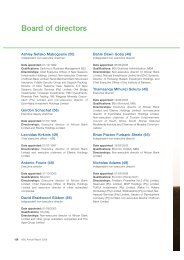Full annual report - African Bank - Investoreports
Full annual report - African Bank - Investoreports
Full annual report - African Bank - Investoreports
You also want an ePaper? Increase the reach of your titles
YUMPU automatically turns print PDFs into web optimized ePapers that Google loves.
offsite disaster recovery centre is tested <strong>annual</strong>ly. Testing<br />
includes simulation of a disaster event whereby key users of<br />
systems are requested to test the functionality of the<br />
recovered system at the disaster recovery centre. Generators<br />
and uninterrupted power supply capabilities at the central<br />
offices and key sites minimise disruptions from power<br />
outages.<br />
The <strong>Bank</strong>ing unit has the ability to switch its main debtors<br />
management and front end system to run interchangeably<br />
between the disaster recovery and live sites, reducing<br />
potential downtime to less than 30 minutes in the event of a<br />
disaster. The Retail unit has secured a syndicated offsite<br />
facility, fully configured to which it can relocate in the event of<br />
the loss of their central office.<br />
Appropriate insurance cover exists to provide effective cover<br />
against business continuity disasters.<br />
Financial risk<br />
ABIL’s strategy and core competence resolves around the<br />
underwriting of unsecured credit, primarily focusing on and<br />
leveraging its appetite for credit risk (refer credit risk section<br />
page 118 for detailed information). All other financial risks,<br />
such as interest rate risk, market risk and tax risk, are mitigated<br />
to levels that are acceptable to the group.<br />
Interest rate risk management<br />
In line with this philosophy relating to financial risk, the group<br />
has a policy of maintaining a neutral view to interest rate risk.<br />
Given that the nature of the loans that the group offers are<br />
predominantly at fixed rates of interest, funding is raised<br />
primarily at fixed rates to match this profile. Most variable<br />
rate funding is swapped into a fixed rate exposure by way of a<br />
directly matched interest rate derivative or an appropriate<br />
inflation derivative. To the extent, however, that the growing<br />
credit card portfolio exposes the <strong>Bank</strong> to floating interest rate<br />
returns, an increasing portion of the funding raised by the<br />
<strong>Bank</strong> will be done on a floating rate basis, thus matching our<br />
assets to our liabilities. This strategy results in a steady<br />
funding cost and low interest rate exposure through<br />
the cycles.<br />
Despite the group’s policy of maintaining a neutral view,<br />
there will inevitably be some residual interest rate exposures<br />
across the yield curve, and in this regard the group would only<br />
enter into derivative hedging instruments where the exposure<br />
exceeded internal tolerances and the cost of the hedge is<br />
economically viable.<br />
128<br />
The group risk committee has set a limit for the effect of a 2%<br />
movement in the yield curve to be no more than 1,75% of<br />
headline earnings on a 12-month basis. Refer to the sensitivity<br />
analysis on page 293 and 294 of the <strong>annual</strong> financial<br />
statements for a discussion of the impact of interest rate<br />
movements on the profitability of the group.<br />
Market risk<br />
The group avoids exposing itself to any other financial market<br />
risk, such as foreign currency, equity or commodity price<br />
movement risk. As the EMTN programme is utilised to raise<br />
funding in foreign currencies, the <strong>Bank</strong> will be careful to<br />
neutralise any cross currency movement risk by way of<br />
entering into appropriate cross-currency swaps, both as to<br />
the settlement of the capital in local currency terms and the<br />
settlement of future coupon and capital payments in foreign<br />
currency terms. In the Retail unit, the group uses forward<br />
cover to protect itself against any currency exposure related<br />
to the importing of merchandise.<br />
The group invests its cash resources predominantly in the<br />
short term interbank money markets, and limits are set for<br />
exposures to any bank based on its capital base and stability<br />
The only derivative contracts the group has entered into,<br />
relate to:<br />
■ The hedging of the group’s long term share based incentive<br />
scheme, and the nature of the hedge contract is a contract<br />
for differences (CFD) on the underlying ABIL share, which<br />
matches exactly the profile of the long term incentive plan<br />
exposure; and<br />
■ The hedging of residual interest exposure as discussed<br />
under interest rate risk management.<br />
The group does not undertake any speculative trading in<br />
derivatives.<br />
Tax risk<br />
Tax risk ordinarily arises when certain transactions are<br />
structured in order to optimise the tax benefits of such a<br />
transaction. In line with ABIL’s stance on risks not associated<br />
with its core business, we have taken a conscious decision<br />
not to enter into any transactions which may be structured<br />
on a tax aggressive basis nor that may be dependent on<br />
tax base. Appropriately qualified and experienced internal<br />
and external tax resources are used extensively to review<br />
business practices to ensure proper compliance with<br />
tax legislation.


